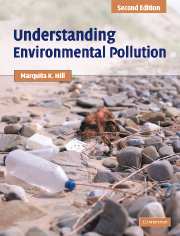Book contents
- Frontmatter
- Contents
- Preface
- Acknowledgements
- List of abbreviations and acronyms
- Chapter 1 Understanding pollution
- Chapter 2 Reducing pollution
- Chapter 3 Chemical toxicity
- Chapter 4 Chemical exposures and risk assessment
- Chapter 5 Air pollution
- Chapter 6 Acidic deposition
- Chapter 7 Global climate change
- Chapter 8 Stratospheric-ozone depletion
- Chapter 9 Water pollution
- Chapter 10 Drinking-water pollution
- Chapter 11 Solid waste
- Chapter 12 Hazardous waste
- Chapter 13 Energy
- Chapter 14 Persistent, bioaccumulative, and toxic
- Chapter 15 Metals
- Chapter 16 Pesticides
- Chapter 17 Pollution at home
- Chapter 18 Zero waste, zero emissions
- Index
- References
Chapter 18 - Zero waste, zero emissions
- Frontmatter
- Contents
- Preface
- Acknowledgements
- List of abbreviations and acronyms
- Chapter 1 Understanding pollution
- Chapter 2 Reducing pollution
- Chapter 3 Chemical toxicity
- Chapter 4 Chemical exposures and risk assessment
- Chapter 5 Air pollution
- Chapter 6 Acidic deposition
- Chapter 7 Global climate change
- Chapter 8 Stratospheric-ozone depletion
- Chapter 9 Water pollution
- Chapter 10 Drinking-water pollution
- Chapter 11 Solid waste
- Chapter 12 Hazardous waste
- Chapter 13 Energy
- Chapter 14 Persistent, bioaccumulative, and toxic
- Chapter 15 Metals
- Chapter 16 Pesticides
- Chapter 17 Pollution at home
- Chapter 18 Zero waste, zero emissions
- Index
- References
Summary
“The time has come for humankind not to expect the Earth to produce more, but rather to do more with what the Earth already produces.”
Belgium industrialist, Gunter PauliHow can we speak of zero waste or zero emissions if, as you learned earlier no process is 100% efficient? The answer is that zero waste is a philosophy, one that says there is no waste: what we call “waste” or “pollutant” is really a useful resource. This philosophy recognizes too that, if we aspire to reduce waste by 100%, we accomplish more than if our goal was 40% or 80%.
Sections I to III below emphasize dematerialization, reducing the quantities of materials we use. Section I asks how well we are doing in reducing waste and pollution, and looks at the waste that the United States produces. Section II discusses industrial ecology, a discipline with the goal of enmeshing industrial society into the environment. It also raises the idea of increasing our efficiency in resource use 4-fold, perhaps as much as 10- to 20-fold. Section III examines tools useful in working toward zero waste, including life-cycle assessment (LCA) and design for the environment (DfE). Other tools too point toward ways to reduce use of resources: servicizing and product stewardship. Section IV takes us to detoxification; that is, changing the chemicals we use and how we produce them, “green chemistry.” The intention is to reduce chemical risk to humans and the environment. Finally, Section V asks, is there progress toward zero waste?
- Type
- Chapter
- Information
- Understanding Environmental PollutionA Primer, pp. 427 - 451Publisher: Cambridge University PressPrint publication year: 2004

